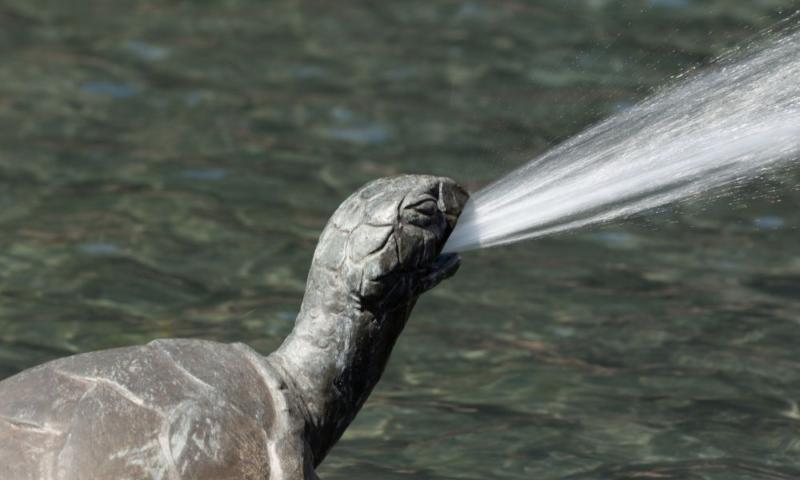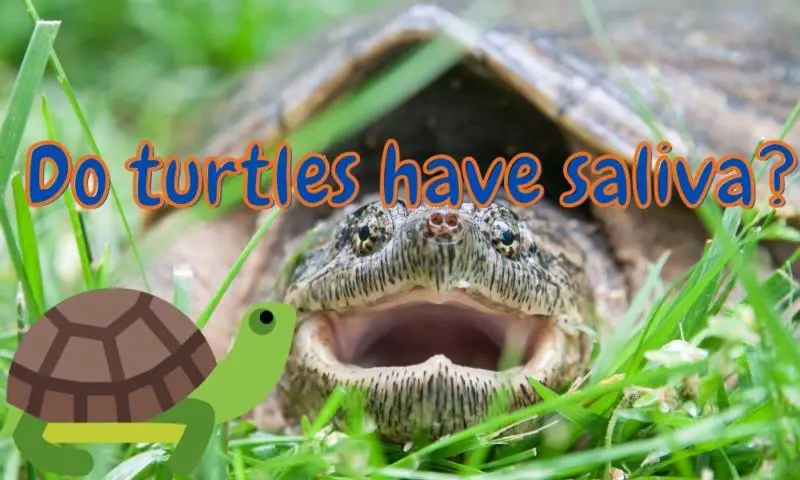I have previously written about how fish, sharks and whales do not produce saliva because they are fully submerged in water. If you spent all your time in the water, making extra liquid for lubrication to aid swallowing of food does not make sense.
Therefore, many sea-dwelling animals have completely lost their ability to produce saliva!
On the other hand, most reptiles spend their time on land and do therefore need a certain amount of lubrication to swallow their (often dry) food. Some lizards, like the marine iguana, spent quite some time foraging at sea, but it does still produce saliva (and sneeze out salt water!).
But what about turtles, do they make any saliva?
Yes – turtles do make saliva but not as much other reptiles do! Most turtles do not have as well developed salivary glands as most land animals.
While turtles do have salivary glands, they are not very developed and mostly release enzymes directly to aid in digestion but not much liquid to aid in swallowing of food.
In contrast to fish, turtles are reptiles that are not always submerged in water, and these represent a group of species that are good examples of in-between (fish and terrestrial mammals) evolutionary solutions.
Unlike fish and turtles, saliva plays a very important role in our (human and most mammals) digestion.
It is produced from glands in the mouth, these glands produce enzymes that help break down food into smaller particles so they can be more easily swallowed and digested. In humans, it also contains mucus which helps protect the digestive tract from harmful bacteria and a lot of liquid that makes it easier to swallow food.
As a general rule, the more time an animal species spends in the water, the less developed their salivary function.
Because the phylogenetic group of turtles contain species that live predominantly on land (tortoises) and almost exclusively in water (sea turtles), these animals are very interesting from a saliva evolution point of view! That is, turtles are reptiles that live in the water or on land. Tortoises are a subset of turtles that live mostly on land.
Tortoises spend most of their time on land and will therefore have more well developed salivary glands compared to sea dwelling turtles to aid in swallowing.
Can turtles eat on dry land?

It is clear when looking at the salivary function of land turtles that they are able to eat just fine by just supplementing with a bit of water, while sea turtles would never be able to digest their food properly on land.
Just like it is the case for whales, aquatic turtles do not produce the same amount of oral liquids as pure land dwelling animals. This is likely because they already get enough liquid from the water where they spend most of their time.
Because sea turtles do not actually produce saliva, and dont have teeth to liquify their food, they need to ingest water to eat food. They swallow the fluid and then pull it back into their mouths to assist in swallowing.
When a turtle swallows, it retracts its head and pulls its neck inwards, pushing the buccopharynx against the water or food. This causes a seal to form around the food or liquid, which is then pulled into the stomach through suction created by tight muscles around the esophagus. So called “gular pumping”.
And while many species of turtles are able to find food on land, most aquatic turtle species need to go back into the sea to swallow their food!
This is because they do not produce enough saliva to swallow their food on land.
Why do turtles spit?
Unlike the spitting of archerfish, turtles are not trying to scare you away or hunt prey when spitting out water!
Turtles may spit out water for several reason.

One reason is that turtles use water as a substrate for smelling. They lead in water across their olfactory nerves to sense their surroundings.
Another reason is related to what I mentioned above, about using water as a kind of external saliva to help swallow their food. Sometimes turtles ingest too much water and need to expel some of it again to make space for their next meal.
Finally, turtles may also simply have ingested too much water while diving, and wanting to make room for breathing air again, like whales, when reemerging to the surface.
Sea turtles have a distinct mechanisms to ensure that they don’t swallow too much sea water when eating, where they slowly swallow their food while separating it from the water that eventually gets propelt out through their nostrils!
See the video below for more information on how sea turtles eat and avoid ingesting their salty surroundings:
However, always remember, if your pet turtle seems like drooling or, bubbles are continuously coming out of its mouth, this may be a sign of disease and you should contact your vet.
Conclusion
To sum up, turtles, like other reptiles do produce saliva, but it does not produce any mucus or a lot of liquid as most other terrestrial animals. This can be explained by their close association to water, that has lead them to rely more on external sources of lubrication when swallowing their food.
Turtles do, however, still have salivary glands that aid in digestion by secreting enzymes, but it does not play a major role in their food processing.
But you might want to be careful before offering them finer sands as substrates as they can get stuck in their mouths.





